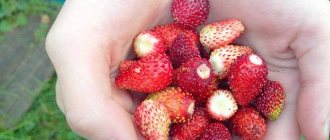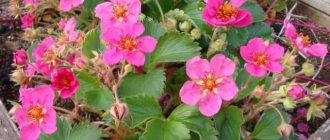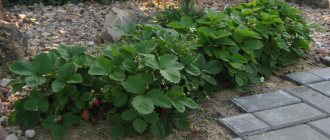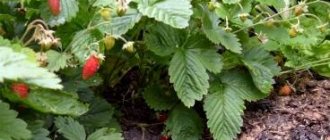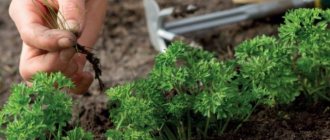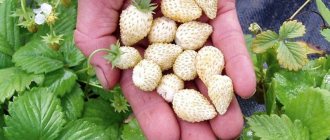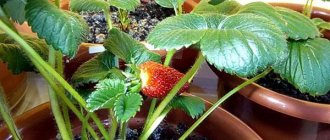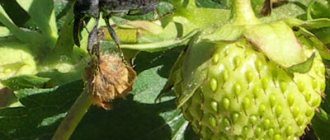Description and varietal characteristics
The strawberry variety “Lyubasha” is characterized by the formation of powerful semi-spreading bushes. There is no formation of whiskers on berry plantings of this variety. The stalks are thick and strong. The berries have a regular conical shape. The average weight of a fully ripened berry is 18-22 g. A distinctive feature of ripe pulp is the increased content of vitamin C and sugars.
According to most consumers, the taste of ripe strawberries is excellent. The pulp is very sweet, with a pronounced strawberry aroma. According to the tasting results, the variety received a score of 4.9 points. The collected berries are perfect for freezing for the winter.
Large-fruited garden strawberries "Lyubasha" belong to the winter-hardy category. Unlike varieties of classic garden strawberries, their flowering is continuous and fruiting is very long. In the soil and climatic conditions of central Russia, the fruit formation period is three months. When this remontant variety is cultivated in the southern regions, fruiting lasts about five months.
How to grow strawberries from seeds. Part 1. Remontant strawberry Lyubasha and other varieties
Among the new products received were three hybrids f1 Sweet Tooth, Taste of Childhood, Droplet of Summer and one variety of remontant strawberry Lyubasha. All seeds are from Aelita.
The characteristics of the three hybrids indicate the presence of mustaches and fruiting on the main bush and on new rosettes. The berries are promised to be dense, large, and yield from 0.8 to 1.5 kg per bush.
Strawberry Lyubasha variety description
Strawberry Lyubasha variety description was similar. A distinctive feature is the absence of a mustache. It should be noted that the originator of this variety is the same Aelita, and the variety itself was included in the state register in 2011. There's a little more information about him there.
- So, Lyubasha is a remontant, early strawberry, the purpose of the variety is universal. The bush should be powerful and not form a mustache.
- Lyubasha has medium-sized leaves with pubescence and shine. The teeth of the leaves are wide, and the shape is oval-rhombic. The leaf petiole is also pubescent and thick. The flowers are medium sized and white.
- Remontant strawberry Lyubasha is positioned as a supplier of aromatic, large (weighing 12-23 grams) berries of a regular conical shape. They have a sweet taste, the tasting score of which is 4.9 points. This feature is emphasized in the description of the variety on the bag of seeds.
- The average yield is indicated for industrial production and is up to 104 centners per hectare. The variety is also characterized by high winter hardiness, average resistance to drought, heat and major diseases. The variety copes poorly with strawberry mites.
This is the description of the Lyubasha strawberry variety. Well, we'll see, and then we'll tell you.
Remontant strawberry Lyubasha
As for other seeds, the selected hybrids are generally similar to each other. The brief characteristics written on the packages determine that these will be spreading bushes up to 30 cm in height, leafy, with fruiting rosettes on the tendrils. The harvest can be obtained already in the first year, 4-5 months after germination.
Differences will most likely be observed in the shape and taste of the berries. At the familiarization stage, when the seeds were taken out of the packages, there were no differences between them.
Remontant strawberry Lyubasha has a wide time limit for sowing: from February to June. It is assumed that with later planting, the first harvest will be in the autumn. It is proposed to sow hybrids no later than March. Their fruiting period is noted from June to September.
Droplet of Summer, Sweet Tooth and Lyubasha were packaged with 10 seeds per bag. Remontant strawberry Taste of childhood - 7 pieces.
After reviewing the care instructions several times, unpacking the bag of soil and taking a deep breath, I started sowing. Read about how the sowing season took place, as well as the continuation of the story about remontant strawberries from seeds in the next chapter.
Read also: How to close a junction box in the wall
Advantages and disadvantages
Remontant varieties of garden strawberries have great advantages compared to the classic varieties of this berry crop:
- high level of productivity of berry plantings;
- sufficient indicators of frost resistance and winter hardiness;
- the opportunity to obtain a large, marketable berry;
- after the first fruiting, the plant again sets buds and sets berries, which allows you to get several full harvests per season;
- resistance to the main most common diseases at the level of standard varieties;
- sufficient indicators of drought resistance and heat resistance;
- excellent taste of fully ripened berries;
- possibility of universal use of the harvested crop.
The disadvantages of remontant varieties, including “Lyubasha,” include the need to grow using seedlings. It is recommended to sow seeds from February to July. Planting seedlings on ridges in open ground is done when five or six true leaves appear on the bush.
The formation of flower buds on remontant varieties of garden strawberries for the second harvest begins during the first flowering. After harvesting the ripened berries, repeated, quite abundant flowering occurs. Due to this feature, caring for remontant strawberries is slightly different from working with conventional varieties of this berry crop.
Note: About the benefits of nest eggs
I want to share my experience in growing remontant strawberry seedlings. I'll start in order. In February of this year, I sowed store-bought seeds. Out of four bags of different varieties, only seven plants sprouted. I was upset by this result: after all, the packages indicated that this was high-quality planting material. And then I remembered that I had one stash in my bins. Two years ago I had such a generous harvest of remontant strawberries that I even put the berries through an electric dryer, then putting them in paper bags.
When I ate these gifts of summer in winter, I found seeds in the bags that had fallen off the fruits, which I did not throw away and put them aside just in case. And it turns out that she didn’t do it in vain!
I took the risk of sowing these seeds in containers with soil. And what do you think? They all sprouted and began to grow quickly. In May, I planted all the seedlings in open ground. But I didn’t admire the strawberry bed for long: the insidious return frosts seriously “shocked” my plantings. And then I sowed the remaining seeds directly into the ground between the frozen bushes (again I saved some of them, and again not in vain!). And they rose quickly, but very often. I fed them and, without replanting, left them until winter.
Read also: How to prune persimmons in the fall in the Krasnodar region
We'll see how they survive the winter. But the main idea is this: in the spring there are already a lot of different seedlings to grow, but, as always, there is not enough space for them at home. And here it turns out that in the spring you can sow your prepared seeds immediately on a prepared bed, so that you can then calmly plant them in a permanent place. This is how tips on growing plants come unexpectedly.
© Author: Olga Vasilyeva ULYANOVA p. Kichmengsky Town, Vologda region. Samara region
Large-fruited strawberry Lyubasha deserves special attention. Thanks to its juicy, aromatic fruits and easy care, summer residents often want to see it on their plots. This variety is characterized by good yield and unpretentiousness. To enjoy berries throughout the season, it is enough to follow a number of simple rules.
Features of care and harvesting
The main condition for obtaining a good strawberry harvest is the creation of the most favorable growing conditions that can ensure normal growth and development of the berry crop:
- the area for strawberries must be dug up and completely cleared of plant debris and weeds;
- watering is carried out as the soil dries, in the early morning and late evening, with warm water;
- It is not recommended to use fresh manure for fertilizing;
- the best fertilizers are humus, bird droppings, as well as mineral, phosphorus and potassium compounds;
- when planting seedlings for the first time, 10 kg of organic matter and approximately 30-34 g of minerals should be added to the soil;
- In early spring and autumn, it is necessary to remove old and dry leaves from the plant.
It is very important to carry out timely preventive measures and spraying aimed at protecting berry plantations from diseases and pests. In the spring, after removing old leaves from the plant, but before the flowering stage, the berry bushes are sprayed with iodine solution, Bordeaux mixture or copper oxychloride.
Ripe berries are collected in several stages, at the stage of full ripening. Strawberries on the bushes should not be allowed to overripe: this can provoke rot and reduce the overall yield, as well as deteriorate the quality of the berries.
How to properly grow strawberries from seeds?
Many amateurs believe that this type of crop can only be propagated by seedlings. In fact, there is another, no less effective way. Growing Lyubasha strawberries from seeds is popular all over the world. It is not difficult, but in order to get a young plant, you will need to wait a while.
- Collection of seeds. You need to select grains from varietal bushes. Berries should only be taken when they are ripe. Place the collected seeds on paper to dry. It is best to keep them in a well-ventilated area. If this is not observed, the remaining pulp may begin to rot. After a few days, transfer the planting material to a fabric bag.
- Soil for growing seedlings. Strawberries should be sown in a nutrient substrate. The best option would be a universal primer. You can also prepare the land yourself. To do this, you will need to mix part of the peat and sand, as well as two parts of turf soil. If possible, add a little ash to the resulting mixture. Then calcine the soil at high temperature or water it with a weak solution of potassium permanganate.
- Stratification. Strawberry grains take a very long time to germinate, so to speed up the process, you should stratify the seeds. This is a procedure that involves keeping planting material for a long time at a certain temperature. The stratification period lasts about three months. You can keep grains in the cellar or on the bottom shelf of the refrigerator.
- Sowing seeds. Soak the prepared planting material in rainwater and keep it in the liquid for three days. This time will be enough for the seeds to swell. Then wrap them in a damp cloth and make sure that the paper does not dry out. Those grains that begin to germinate can be transplanted into a box with substrate.
Seeds should be sown in February. This is due to the fact that this type of plant takes a very long time to germinate and develops slowly. You can speed up the growth process by installing a lamp near the flowerpot. This is especially true for cloudy days and winter months, when the sun rarely appears outside.
Containers with seedlings should only be placed in a warm place. Also, the top of each box can be covered with polyethylene. Thanks to the mini-greenhouse, the optimum temperature, which is most suitable for strawberries, is maintained in the middle of the vessel throughout the entire period of time.
Seeds can also be sown in the classic way, but the guarantee that they will all sprout is low. The first shoots are observed after 20-30 days.
After preparing the soil for planting strawberry seeds, it should stand in a cool place for three weeks.
The description of the strawberry variety Lyubasha, which is presented above, fully confirms the positive reviews of gardeners who consider this plant to be the best. To grow this fragrant berry on your own plot, it is enough to follow a sequence of actions and simple rules of care.
Video review of strawberry seedlings
Tips and reviews from gardeners
The strawberry variety "Lyubasha" is unpretentious. According to reviews from experienced summer residents, plants are very responsive to periodic loosening of the soil, which allows air access to the root system of the berry crop. It is also important, if necessary, to add fertile soil to protect the root system from exposure. It is recommended to carry out periodic inspections of strawberry bushes, as well as regularly remove weeds from the ridges. Ripening berries should not be placed on the soil. It is necessary to lift them using ring-shaped wire supports.
Growing garden strawberries "Lyubasha" is not difficult, so this variety is perfect for cultivation by novice gardeners.
